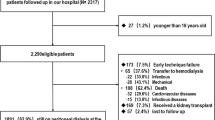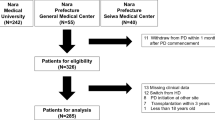Abstract
Purpose
This study used national claims data to investigate the technique and patient survival over time in incident peritoneal dialysis (PD) patients.
Methods
Incident end-stage renal disease patients undergoing PD and older than 18 years were selected from Taiwan health insurance databases. These patients were grouped into three study periods according to year of dialysis initiation: 1997–2001, 2002–2006, and 2007–2011. The study end-points included technique failure and mortality.
Results
The patients in the most recent era were older and more likely to have higher levels of comorbidity. Compared with the 1997–2001 group, the risks of technique failure were similar in the in the 2002–2006 (hazard ratio [HR] 1.10, 95 % confidence interval [CI] 0.98–1.24) and 2007–2011 groups (HR 1.11, 95 % CI 0.98–1.26), respectively. Relative to the 1997–2001 group, the risks of mortality were higher in the 2002–2006 group (HR 1.59, 95 % CI 1.26–2.02) and similar in the 2007–2011 group (HR 1.20, 95 % CI 0.93–1.55). Using icodextrin and automated peritoneal dialysis (APD) were associated with lower risks of technique failure (HR 0.62 and 0.86, 95 % CI 0.56–0.68 and 0.77–0.95, respectively) and mortality (HR 0.55 and 0.81, 95 % CI 0.45–0.66 and 0.67–0.99, respectively).
Conclusions
Despite increase in disease burden in the most recent era, the outcomes remained relatively stable. The use of APD and icodextrin appears to have significantly ameliorated the impact of the increase in comorbidity burden.

Similar content being viewed by others
References
U.S. Renal Data System, USRDS 2014 annual data report: atlas of chronic kidney and end-stage renal disease in the United States, National Institute of Health, National Institute of Diabetes and Digestive and Kidney Diseases, Bethesda, MD
Lee H, Manns B, Taub K, Ghali WA, Dean S, Johnson D, Donaldson C (2002) Cost analysis of ongoing care of patients with end-stage renal disease: the impact of dialysis modality and dialysis access. Am J Kidney Dis 40(3):611–622. doi:10.1053/ajkd.2002.34924
U.S. Renal Data System, USRDS 2007 Annual data report: atlas of chronic kidney and end-stage renal disease in the United States, National Institute of Health, National Institute of Diabetes and Digestive and Kidney Diseases, Bethesda, MD
Yeates K, Zhu N, Vonesh E, Trpeski L, Blake P, Fenton S (2012) Hemodialysis and peritoneal dialysis are associated with similar outcomes for end-stage renal disease treatment in Canada. Nephrol Dial Transplant 27(9):3568–3575. doi:10.1093/ndt/gfr674
Mehrotra R, Chiu YW, Kalantar-Zadeh K, Bargman J, Vonesh E (2011) Similar outcomes with hemodialysis and peritoneal dialysis in patients with end-stage renal disease. Arch Intern Med 171(2):110–118. doi:10.1001/archinternmed.2010.352
Perl J, Wald R, Bargman JM, Na Y, Jassal SV, Jain AK, Moist L, Nessim SJ (2012) Changes in patient and technique survival over time among incident peritoneal dialysis patients in Canada. Clin J Am Soc Nephrol 7(7):1145–1154. doi:10.2215/CJN.01480212
Perl J, Wald R, McFarlane P, Bargman JM, Vonesh E, Na Y, Jassal SV, Moist L (2011) Hemodialysis vascular access modifies the association between dialysis modality and survival. J Am Soc Nephrol 22(6):1113–1121. doi:10.1681/ASN.2010111155
Mehrotra R, Chiu YW, Kalantar-Zadeh K, Vonesh E (2009) The outcomes of continuous ambulatory and automated peritoneal dialysis are similar. Kidney Int 76(1):97–107. doi:10.1038/ki.2009.94
Badve SV, Hawley CM, McDonald SP, Mudge DW, Rosman JB, Brown FG, Johnson DW (2008) Automated and continuous ambulatory peritoneal dialysis have similar outcomes. Kidney Int 73(4):480–488. doi:10.1038/sj.ki.5002705
Wang IK, Li YF, Chen JH, Liang CC, Liu YL, Lin HH, Chang CT, Tsai WC, Yen TH, Huang CC (2015) Icodextrin decreases technique failure and improves patient survival in peritoneal dialysis patients. Nephrology (Carlton) 20(3):161–167. doi:10.1111/nep.12375
Han SH, Ahn SV, Yun JY, Tranaeus A, Han DS (2012) Effects of icodextrin on patient survival and technique success in patients undergoing peritoneal dialysis. Nephrol Dial Transplant 27(5):2044–2050. doi:10.1093/ndt/gfr580
Davies SJ, Woodrow G, Donovan K, Plum J, Williams P, Johansson AC, Bosselmann HP, Heimburger O, Simonsen O, Davenport A, Tranaeus A, Divino Filho JC (2003) Icodextrin improves the fluid status of peritoneal dialysis patients: results of a double-blind randomized controlled trial. J Am Soc Nephrol 14(9):2338–2344
Davies SJ, Brown EA, Frandsen NE, Rodrigues AS, Rodriguez-Carmona A, Vychytil A, Macnamara E, Ekstrand A, Tranaeus A, Filho JC (2005) Longitudinal membrane function in functionally anuric patients treated with APD: data from EAPOS on the effects of glucose and icodextrin prescription. Kidney Int 67(4):1609–1615. doi:10.1111/j.1523-1755.2005.00243.x
Garcia-Lopez E, Lindholm B, Davies S (2012) An update on peritoneal dialysis solutions. Nat Rev Nephrol 8(4):224–233. doi:10.1038/nrneph.2012.13
Bredie SJ, Bosch FH, Demacker PN, Stalenhoef AF, van Leusen R (2001) Effects of peritoneal dialysis with an overnight icodextrin dwell on parameters of glucose and lipid metabolism. Perit Dial Int 21(3):275–281
Bieber SD, Burkart J, Golper TA, Teitelbaum I, Mehrotra R (2014) Comparative outcomes between continuous ambulatory and automated peritoneal dialysis: a narrative review. Am J Kidney Dis 63(6):1027–1037. doi:10.1053/j.ajkd.2013.11.025
de Fijter CW, Oe LP, Nauta JJ, van der Meulen J, Verbrugh HA, Verhoef J, Donker AJ (1994) Clinical efficacy and morbidity associated with continuous cyclic compared with continuous ambulatory peritoneal dialysis. Ann Intern Med 120(4):264–271
Johnson DW, Hawley CM, McDonald SP, Brown FG, Rosman JB, Wiggins KJ, Bannister KM, Badve SV (2010) Superior survival of high transporters treated with automated versus continuous ambulatory peritoneal dialysis. Nephrol Dial Transplant 25(6):1973–1979. doi:10.1093/ndt/gfp780
Sun CY, Lee CC, Lin YY, Wu MS (2011) In younger dialysis patients, automated peritoneal dialysis is associated with better long-term patient and technique survival than is continuous ambulatory peritoneal dialysis. Perit Dial Int 31(3):301–307. doi:10.3747/pdi.2010.00072
Chaudhary K, Sangha H, Khanna R (2011) Peritoneal dialysis first: rationale. Clin J Am Soc Nephrol 6(2):447–456. doi:10.2215/CJN.07920910
Nessim SJ, Bargman JM, Austin PC, Story K, Jassal SV (2009) Impact of age on peritonitis risk in peritoneal dialysis patients: an era effect. Clin J Am Soc Nephrol 4(1):135–141. doi:10.2215/CJN.02060508
Whaley-Connell A, Pavey BS, Satalowich R, Prowant BF, Misra M, Twardowski ZJ, Nolph KD, Khanna R (2005) Rates of continuous ambulatory peritoneal dialysis-associated peritonitis at the University of Missouri. Adv Perit Dial 21:72–75
Acknowledgments
The present study was supported China Medical University Hospital (DMR-101-044, DMR-105-021, and DMR-104-015); the research laboratory of pediatrics, Children’s Hospital of China Medical University; the Clinical Trial and Research Center of Excellence, Ministry of Health and Welfare (MOHW105-TDU-B-212-133019); Academia Sinica Taiwan Biobank, Stroke Biosignature Project (BM10501010037); the Stroke Clinical Trial Consortium, National Research Program for Biopharmaceuticals (MOST 104-2325-B-039-005); the Tseng-Lien Lin Foundation, Taichung, Taiwan; the Taiwan Brain Disease Foundation, Taipei, Taiwan; and the Katsuzo and Kiyo Aoshima Memorial Funds, Japan. All the authors declared that they have no relevant financial interests.
Author contributors
I-Kuan Wang designed the study and drafted the manuscript. Chih-Hsin Muo designed the study and conducted the statistical analysis. Chi-Yu Lu, Chiz-Tzung Chang, and Tzung-Hai Yen designed the study and drafted the manuscript. Tsai-Chung Li, Chiu-Ching Huang, and Fung-Chang Sung designed the study and revised the manuscript.
Funding/support
This study was supported in part by the Taiwan Ministry of Health and Welfare Clinical Trial and Research Center of Excellence (MOHW105-TDU-B-212-133019); the research laboratory of pediatrics, Children’s Hospital of China Medical University, China Medical University (DMR-101-044, DMR-105-021, and DMR-104-015); Academia Sinica Taiwan Biobank, Stroke Biosignature Project (BM10501010037); National Research Program for Biopharmaceuticals Stroke Clinical Trial Consortium (MOST 104-2325-B-039-005); Tseng-Lien Lin Foundation, Taichung, Taiwan; Taiwan Brain Disease Foundation, Taipei, Taiwan; and Katsuzo and Kiyo Aoshima Memorial Funds, Japan.
Author information
Authors and Affiliations
Corresponding author
Ethics declarations
Conflict of interest
The authors declare that they have no conflict of interest.
Ethical approval
All procedures performed in studies involving human participants were in accordance with the ethical standards of the institutional and/or national research committee and with the 1964 Declaration of Helsinki and its later amendments or comparable ethical standards.
Informed consent
For this type of study formal consent is not required.
Electronic supplementary material
Below is the link to the electronic supplementary material.
Rights and permissions
About this article
Cite this article
Wang, IK., Lu, CY., Muo, CH. et al. Analysis of technique and patient survival over time in patients undergoing peritoneal dialysis. Int Urol Nephrol 48, 1177–1185 (2016). https://doi.org/10.1007/s11255-016-1296-x
Received:
Accepted:
Published:
Issue Date:
DOI: https://doi.org/10.1007/s11255-016-1296-x




